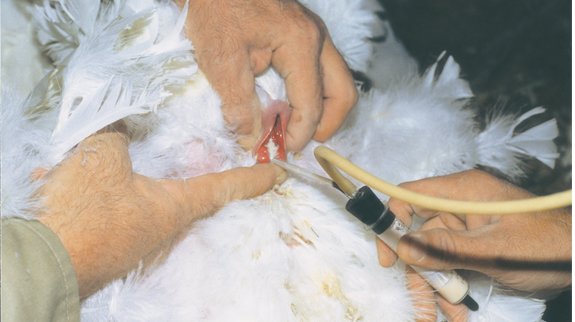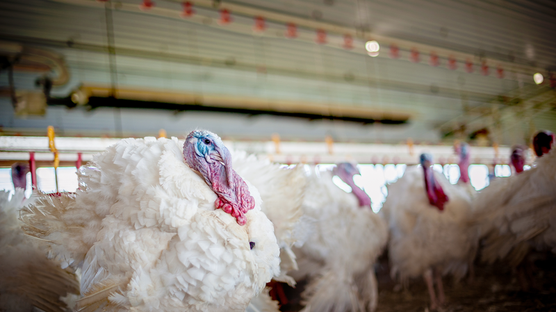
Published on March 19, 2018
Breeder tom management to ensure high quality semen
Artificial insemination is a routine practice in the turkey breeder industry. To be successful it requires trained, competent staff and male turkeys that produce quality semen. This article will focus on some of the key areas of breeder tom management to ensure top quality semen is available for insemination.
Lighting program
While males are in the semen production phase it is important to maintain a minimum of 14 hours of light per day. It has been found this amount and more is best to stimulate semen production. If males are being raised in curtain sided buildings that allow natural light, you must ensure that you have supplemental light to maintain consistent long day lengths as natural days get shorter. It is imperative that you never decrease light duration or light intensity while males are in semen production as this will lead to poor quality semen and can cause a decrease in the quantity of semen produced.
Nutrition
It is important to ensure that proper nutritional needs are met. Feeding regimes and diet compositions should be devised to minimize the development of obesity. A properly weighted male turkey will produce high quality semen with greater ease. It is always important to note that any changes in diet should be done incrementally and in conjunction with a professional nutritionist.
Clean water
Water is a basic need of a turkey. What should be noted is that clean water is what can make a big difference. Clean, sanitized water ensures your birds stay healthy by removing an opportunity for bacteria to enter their bodies. A healthy bird will produce quality semen a lot easier than one with compromised health.
Handling and animal welfare
Stimulation and semen collection requires a high amount of handling, so it is important to ensure gentle treatment during this time. Care must be taken when picking up and releasing the males to prevent bruising or injury.
There are many different ways to handle male turkeys to stimulate ejaculation. While there are some single person techniques, the most common technique requires two people. In the two-person technique there is an ‘operator’ and a ‘milker’. The operator is in charge of holding the bird’s legs and operating the semen collection apparatus. The ‘milker’ is in charge of stimulation, which involves massaging the area around the cloaca. The ‘milker’ must take extra care during aspirations and use no more than 2 strokes. After two strokes, risk of injury to the cloacal area increases, with minimal additional semen being gained. It is important to work with the bird not against the bird. Proper handling will ensure the males achieve maximum quality and quantity of semen to aid in the production of viable, fertile eggs.
Semen Collection
Good quality semen has a thick consistency and a pearly white color. It is important to collect semen off the end of the phallus only. It is equally important to have a slow aspiration rate to avoid damaging the tails of the spermatozoa, which can compromise the quality of the semen.
As sperm is collected, care must be taken to minimizes the collection of unwanted contaminants, such as urates or fecal material. This can be avoided by a few key management tips:
- Do not feed 4-6 hours prior to semen collection
- Maintain adequate lighting for easy visual inspection of the semen quality
- Do not go up the phallus further into the cloacal region during aspiration
Frequency of collection also plays a role in semen quality. Semen from males should be collected once to twice per week. Lapses in collection for extended periods can lead to a lowering of semen production and the quality of spermatozoa. One way to identify if there is a low or reduced number of spermatozoa is that semen may appear grayish in color and watery in consistency.


Summary
There are many factors that contribute to the successful production of top quality semen for insemination. Above we reviewed the key management techniques that can contribute to this success. It should be noted that other factors, such as genetics, health, housing type and flock density, which also play a role in the production of top quality semen. For more information on breeder management visit the Hybrid Turkeys Resources website at http://resources.hybridturkeys.com/breeding-production/male-management



